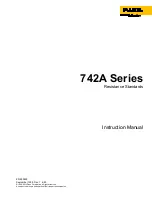
742A Series
Instruction Manual
Figure 4. Connection to Calibrate the 5700A
Operating Temperature Range
You can use the 742A Series in ambient temperatures between 18 and 28
°
C. To
predict the deviation from the nominal at temperatures other than 23
°
C, use the
temperature characterization table provided with each unit. The table shows the
calculated value and the deviation from nominal at temperatures between 18 and
28
°
C in half-degree increments. An example of this table is included as Table 4.
How Temperature Correction Factors are Calculated
A label on the rear panel shows temperature coefficient factors alpha and beta
centered on 23
°
C. (See Figure 2 for the label location.) The values of alpha and
beta are individualized for each 742A. Alpha and beta are established by
measurement in the Fluke Primary Standards Lab at 18
°
C, 23
°
C, and 28
°
C.
The temperature characterization table is generated from these three
measurements and the following formula:
R
t
= R
23
[1+
α
(t – 23 ) +
β
(t – 23 )
2
]
Where,
R
t
= Resistance at t
°
C
R
23
= Resistance at 23
°
C
α
= Slope of the curve (ppm/
°
C) at 23
°
C
β
= Rate of change of slope of the curve (ppm/
°
C
2
)
α
and
β
are constants which do not change appreciably over time and hence
need to be determined only once.
In the case of the example 742A-1 used in this manual,
α
and
β
are
calculated as follows:
α
=
6
E
09
.
0
10
6
E
9
.
0
t
)
R
R
(
18
28
−
−
=
−
−
=
∆
−
( )
6
E
034
.
0
25
6
E
85
.
0
R
2
2
t
23
2
)
R
R
(
18
28
−
−
=
−
−
=
−
=
β
∆
+
Where,
R
28
= Resistance at 28
°
C
R
18
= Resistance at 18
°
C
R
23
= Resistance at 23
°
C
∆
t= (28 – 18) = 10
6












